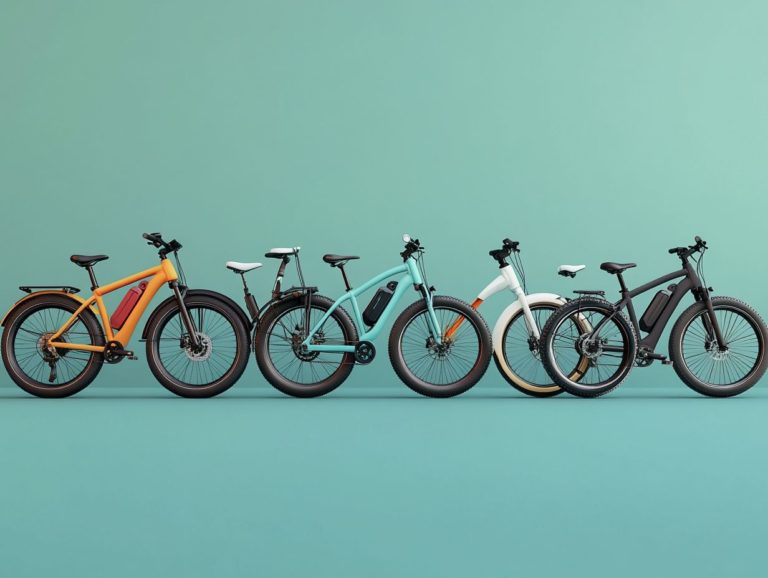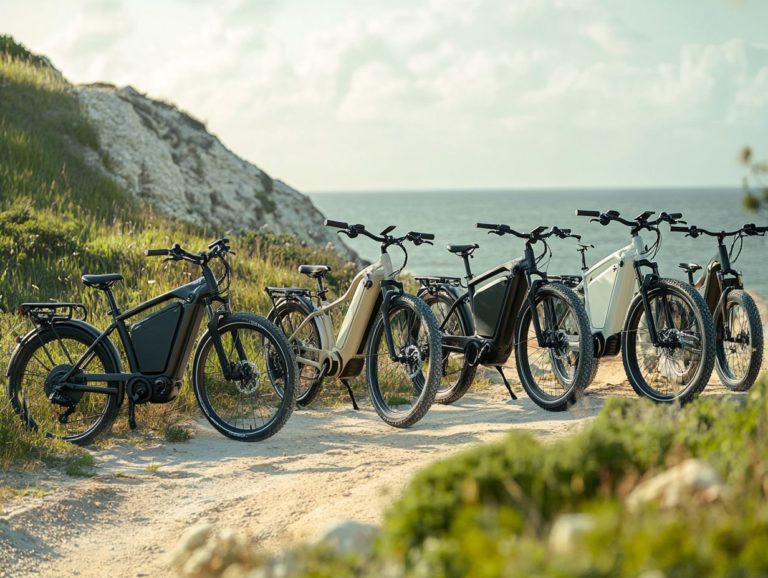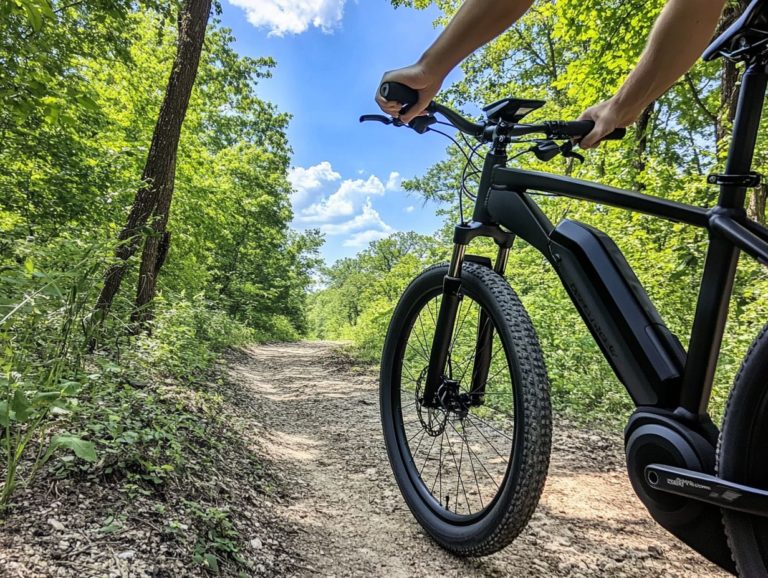5 Common Myths About Electric Bicycle Types
E-bikes are transforming the way we ride, making cycling fun and accessible! Electric bicycles are on the rise, yet they remain shrouded in misunderstanding. You might have encountered misconceptions about their high costs or the belief that they re only for the elderly. These myths obscure the genuine advantages that e-bikes offer.
This article sets out to debunk five prevalent myths surrounding e-bikes, exploring their costs, speed, weight, exercise potential, and environmental impact.
You ll also learn about the various types of e-bikes, how they function, and pick up some valuable tips on maintenance and safety.
Uncover why an electric bicycle could be the perfect choice for you. Don t miss out on the revolution in cycling with e-bikes!
Contents
- Key Takeaways:
- 1. Electric Bicycles Are Too Expensive
- 2. Electric Bicycles Are Slow and Only for the Elderly
- 3. Electric Bicycles Are Heavy and Difficult to Ride
- 4. Electric Bicycles Do Not Provide Enough Exercise
- 5. Electric Bicycles Are Not Environmentally Friendly
- What Are the Different Types of Electric Bicycles and How Do They Compare?
- Frequently Asked Questions
- What are the most common myths about electric bicycle types?
- Are electric bicycles only for people who don’t want to pedal?
- Are electric bicycles more expensive than traditional bicycles?
- Do electric bicycles have a lower top speed compared to traditional bicycles?
- Are electric bicycles heavy and difficult to maneuver?
- Are electric bicycles bad for the environment?
Key Takeaways:
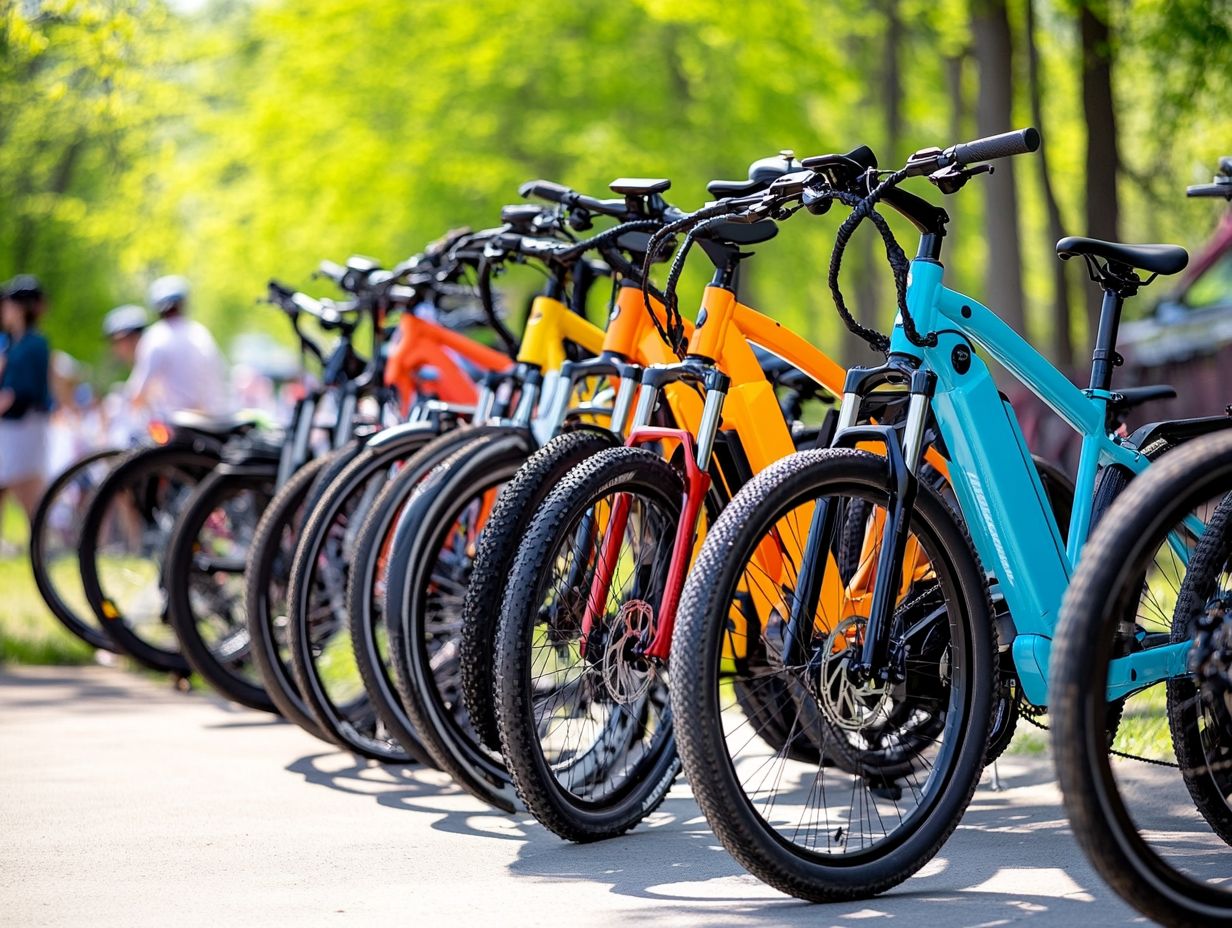
- E-bikes are for everyone, not just the elderly! They come in various styles to fit your needs.
- They can offer a great workout, depending on how you choose to ride.
- Thanks to advancements in tech, many e-bikes are lighter and easier to handle.
1. Electric Bicycles Are Too Expensive
Many think electric bicycles are too expensive, but that s not true! With options from budget-friendly models to premium brands like TENWAYS and Coboc, e-bikes can boost your mobility and lifestyle.
Consider the overall costs, including maintenance and long-term health benefits. In cycling-friendly areas like Colorado, you can tap into public resources that enhance your experience.
Experts like Morgan Lommele and Chris Oliver believe that the overall costs go beyond the initial purchase price. While premium models may demand a higher upfront investment, they often deliver superior durability and longevity, ultimately translating to savings on repairs and replacements.
Financing options are available through various retailers, easing the initial financial strain and broadening access to e-bikes. Research cited by organizations like PeopleForBikes reveals that savings on commuting costs, combined with the health benefits of regular cycling, can balance out expenses over time, further underscoring the value of this sustainable mode of transport.
2. Electric Bicycles Are Slow and Only for the Elderly
Contrary to the prevalent myths surrounding e-bikes, they are not just for the elderly; electric bicycles can significantly enhance your cycling experience, regardless of your age. With features like pedal assist, which means the bike helps you pedal, you ll find that they offer speed and efficiency that rival traditional bicycles.
The pedal assist system allows you to engage the motor simply by pedaling, effectively amplifying your efforts and delivering impressive speeds some models can reach up to 28 mph. This feature proves e-bikes can be fast; recent studies show that the average speed for e-bikes hovers around 20 mph, which is noticeably faster than the typical 12-14 mph of conventional bikes.
This engaging feature appeals to a diverse range of users, particularly younger riders who value the combination of fitness and convenience, as well as urban cyclists in search of efficient, speedy commutes. With the ability to conquer hills and cover longer distances with ease, e-bikes invite a demographic that might have previously found traditional biking a bit daunting.
Join the e-bike movement now and experience the thrill of riding in a whole new way!
3. Electric Bicycles Are Heavy and Difficult to Ride
Many think electric bicycles are heavy and unwieldy. However, recent e-bike technology has brought forth lightweight models.
These designs use lightweight batteries that store energy efficiently, making them easy to ride. Compared to traditional bikes, they are much lighter and more manageable.
New materials like high-strength aluminum and carbon fiber have reduced weight without compromising strength. Riders switching from heavier bikes, often over 60 pounds, to these sleek designs, which usually weigh between 35 and 50 pounds, have felt a noticeable change.
Testimonials from e-bike fans show that these models boost performance and increase cycling enjoyment. The ease of pedaling with these featherweight designs is transforming the cycling experience for everyone!
4. Electric Bicycles Do Not Provide Enough Exercise
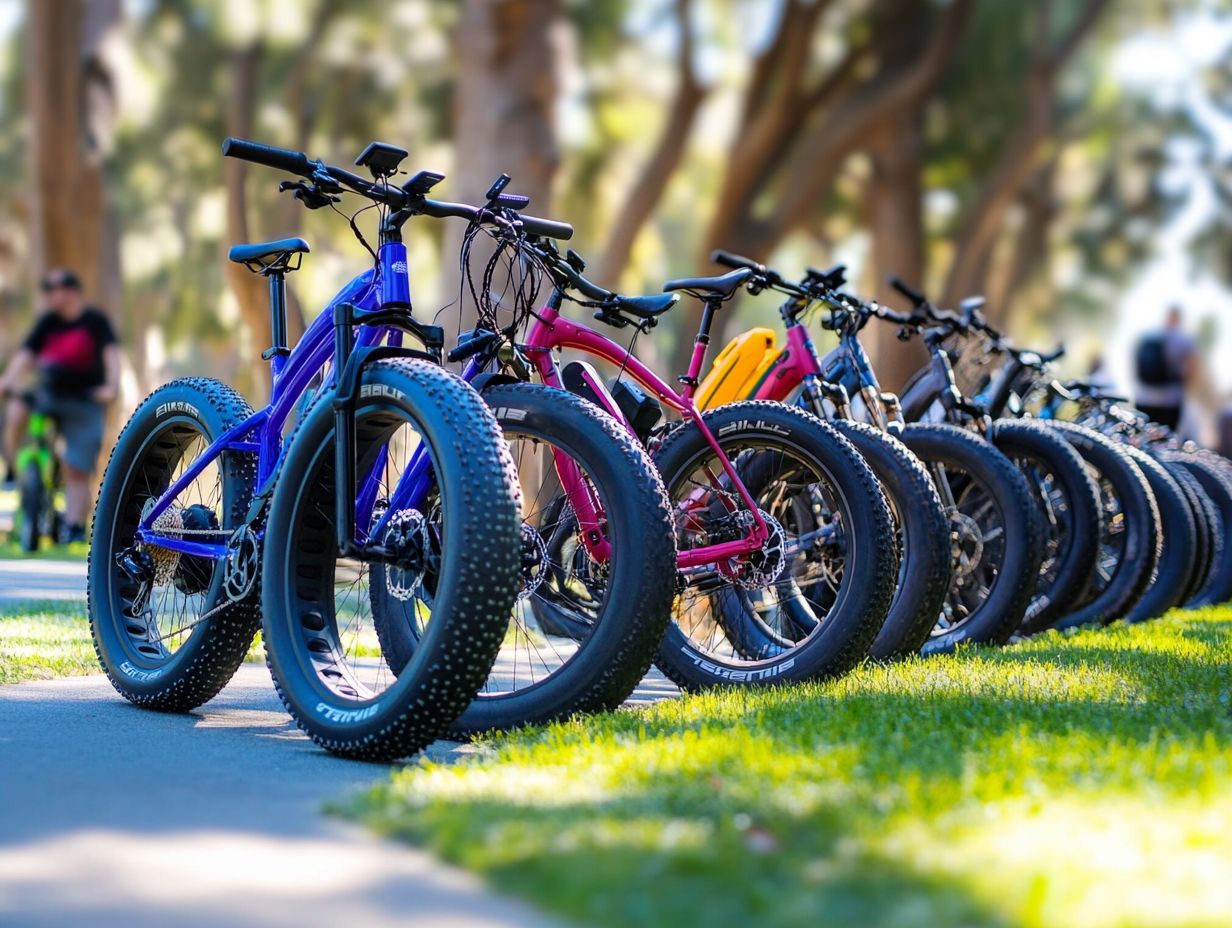
One common misconception about electric bicycles is that they don t offer enough exercise. However, research indicates that e-bike riders actually enjoy significant health benefits, including elevated physical activity levels that can help combat cardiovascular disease and Type II diabetes.
A study from the University of Tennessee found that e-bike users can burn up to 400 calories per hour, which is comparable to traditional cycling, all while enjoying the advantages of electric assist. This feature is particularly beneficial for individuals who may have mobility challenges or those easing back into fitness, allowing them to engage in physical activity without the excessive strain often linked to conventional biking.
The mental health benefits are equally impressive; cyclists frequently report lower anxiety levels and enhanced moods, thanks to the endorphins released during exercise and the sheer joy of discovering new surroundings. E-bikes seamlessly integrate a healthier lifestyle, combining the perks of physical exercise with an enriching cycling experience.
5. Electric Bicycles Are Not Environmentally Friendly
Despite some claims suggesting that electric bicycles aren’t environmentally friendly, the reality is quite different. The technology behind e-bikes and their much lower emissions throughout their life cycle compared to traditional motorized vehicles position them as a sustainable transportation option, especially in eco-conscious areas like Colorado.
E-bikes play a vital role in reducing urban air pollution. Studies demonstrate that they generate much lower emissions throughout their life cycle, considering production, usage, and end-of-life disposal. Unlike traditional vehicles that rely on fossil fuels and continuously emit greenhouse gases, e-bikes are powered by rechargeable batteries. For those interested in understanding more about e-bikes, especially the 5 key differences between e-bike types, this not only helps to ease urban congestion but also enhances overall air quality.
The materials used to build e-bikes are now often sourced sustainably, further shrinking their environmental footprint. Research indicates that cities encouraging e-bike usage see a decrease in noise pollution and an increase in public spaces for pedestrians, highlighting the holistic advantages these bikes offer urban environments. For those interested in fitness, exploring the 5 best electric bicycle types for fitness enthusiasts can be a great option.
What Are the Different Types of Electric Bicycles and How Do They Compare?
Electric bicycles offer an impressive array of styles, each tailored to suit your unique riding preferences and environments. Whether you re navigating bustling city streets or embarking on off-road adventures, e-bikes showcase remarkable versatility in the modern cycling landscape.
Among these, commuter e-bikes truly shine with their lightweight frames and integrated lights, perfectly designed for maneuvering through hectic urban settings. For those interested in exploring the best options, the top 5 electric bicycle types for commuters highlight renowned brands like Trek and Specialized, which are synonymous with reliability and comfort, ensuring your daily commute is as smooth as possible.
Conversely, mountain e-bikes come equipped with robust tires and powerful batteries, enabling you to conquer even the most challenging terrains. For those new to the world of e-bikes, exploring the various electric bicycle types can provide valuable insights. Haibike stands out as a leader in this category, delivering models that inspire confidence on rugged trails.
For those who appreciate the best of both worlds, hybrid e-bikes seamlessly blend the features of commuter and mountain bikes, offering unmatched versatility for various riding conditions. Brands like Cannondale present popular options that cater to this need.
Each type of e-bike not only elevates your riding experience but also addresses specific needs based on your surroundings and intended use, making them the preferred choice for many cycling enthusiasts.
How Do Electric Bicycles Work?
Electric bicycles operate through a sophisticated combination of electric bike technology. They feature an electric bike battery and a pedal assist, which is a feature that helps you pedal easier, to enhance your cycling experience. This combination makes riding more accessible and enjoyable, particularly in bustling urban environments filled with motorized vehicles.
You can conquer steeper hills and longer distances without the usual physical strain of traditional biking. The motor, located in the wheel hub or bike frame, is crucial for your ride, propelling you forward based on your pedal input. Complementing this is the battery, the powerhouse that stores energy, ensuring you can embark on longer rides without frequent stops for a charge. To learn more about the different types of electric bicycles available, check out this comprehensive guide.
Sensor systems further refine your experience by monitoring your pedaling speed and power, adjusting the motor assistance to match your effort. Ultimately, these components work seamlessly together, transforming an ordinary bike ride into a smooth and efficient journey, perfect for both thrilling adventures and practical commuting.
What Are the Benefits of Using an Electric Bicycle?
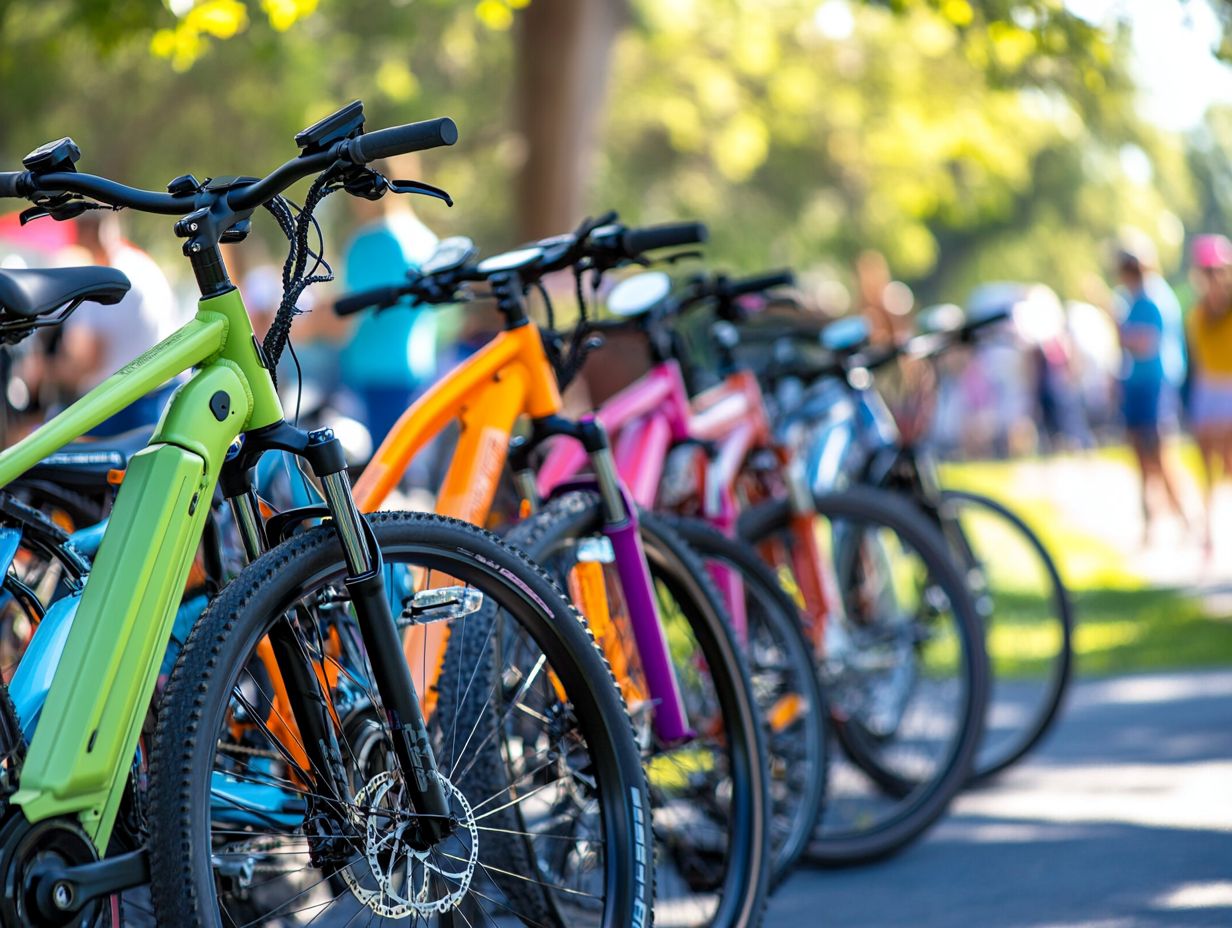
Get ready to boost your fitness and feel great! Using an electric bicycle presents a host of benefits that can elevate your cycling experience to new heights. You ll discover enhanced physical activity, improved mental health, and an overall joy that makes riding an e-bike an enticing option for various riders.
Incorporating e-bike journeys into your daily routine can significantly boost your cardiovascular fitness, elevating your heart rate without the strain that often accompanies traditional cycling. This isn t just good for your body; it also uplifts your spirits, fostering a sense of well-being that helps you tackle everyday stressors with ease.
Numerous riders have shared transformative experiences. For instance, one rider no longer dreads their commute, expressing how the electric bike allows them to maintain a consistent pace while taking in the scenery. Another rider noted a significant mood improvement since they began e-biking, reveling in a newfound sense of freedom and happiness that had eluded them for too long. If you’re curious about options, check out these 5 stylish electric bicycle types for urban riders.
This harmonious blend of physical activity and mental rejuvenation renders e-biking an essential choice for anyone seeking to enhance their quality of life. Don t miss out on a healthier, happier you through e-biking!
What Are the Factors to Consider When Choosing an Electric Bicycle?
When selecting an electric bicycle, you’ll want to weigh several important factors. Consider the features offered by different e-bike manufacturers, the level of pedal assist available, and whether the bike suits your urban commuting needs or recreational pursuits.
Understanding battery life is essential, as it determines how far you can travel on a single charge. Many models offer a range of 20 to 100 miles per charge.
Motor power is another critical aspect, especially when it comes to performance on hills or rough terrain. Options typically span from a moderate 250W to a robust 750W.
The frame style, whether you prefer a classic step-through or a sportier design, can significantly impact your comfort and convenience.
Additionally, considering available accessories like racks, fenders, and lights can greatly enhance your overall riding experience. Make sure it perfectly aligns with your specific needs and preferences.
How Can One Maintain an Electric Bicycle?
Keep your electric bicycle in top shape for a thrilling ride! Proper maintenance is essential for achieving peak performance and ensuring its longevity.
You ll want to focus on common issues that might crop up and keep that electric bike battery in pristine condition. This means engaging in routine checks and preventive measures that can significantly enhance your bike s functionality.
Start by assessing the battery’s health regularly inspect connections for any signs of corrosion and perform periodic charges as recommended by the manufacturer.
Tire maintenance is equally critical. Checking air pressure and tread depth can ward off blowouts and guarantee a smooth ride. Don t overlook brake adjustments; ensuring they engage properly is key for your safety while riding.
Industry experts agree that maintaining a regular schedule for these checks not only prevents minor issues from worsening but also fosters a more enjoyable and reliable riding experience.
What Are the Safety Precautions When Riding an Electric Bicycle?
Safety precautions for riding an electric bicycle are essential for ensuring your well-being and that of others on shared paths, particularly in areas where motorized vehicles are present and trail etiquette varies.
Taking a proactive approach to safety can greatly reduce the chances of accidents and injuries. Wearing a properly fitted helmet is non-negotiable; it should be your first line of defense.
Familiarizing yourself with local traffic laws helps you navigate the streets responsibly and confidently.
By maintaining a suitable speed especially in crowded areas you ll be poised to react swiftly to unexpected situations. Staying aware of your surroundings and the movements of pedestrians and other cyclists enhances your personal safety and contributes to a more harmonious environment for everyone involved.
Embracing trail etiquette, such as yielding to pedestrians and signaling your turns, fosters mutual respect among all users of the trails.
Frequently Asked Questions

What are the most common myths about electric bicycle types?
There are several myths surrounding electric bicycles, including:
- Assume electric bicycles are only for lazy people who don’t want to pedal.
- Think electric bicycles are too expensive.
- Believe electric bicycles are not as fast as traditional bicycles.
- Assume electric bicycles are heavy and difficult to maneuver.
- Think electric bicycles are not environmentally friendly.
Are electric bicycles only for people who don’t want to pedal?
No, electric bicycles are designed to provide assistance to riders, but they still require pedaling. You can choose how much assistance you want from the motor, and you can still pedal for exercise and control.
Are electric bicycles more expensive than traditional bicycles?
While some electric bicycles may have a higher price point, there are also affordable options available. The cost can vary depending on the brand, features, and battery type. However, in the long run, they can actually save you money on transportation costs.
Explore different electric bicycles and consider taking a test ride today!
Do electric bicycles have a lower top speed compared to traditional bicycles?
Electric bicycles can reach speeds up to 20 miles per hour. Some models even exceed the top speeds of traditional bicycles, making them excellent for commuting and longer rides.
Are electric bicycles heavy and difficult to maneuver?
Many electric bicycles are heavier due to the motor and battery. However, recent advancements have made them lighter and easier to handle. Always test ride before buying to find the right fit for you.
Are electric bicycles bad for the environment?
Electric bicycles run on rechargeable batteries and do not pollute while in use. They help reduce car usage, leading to lower carbon emissions and cleaner air.

